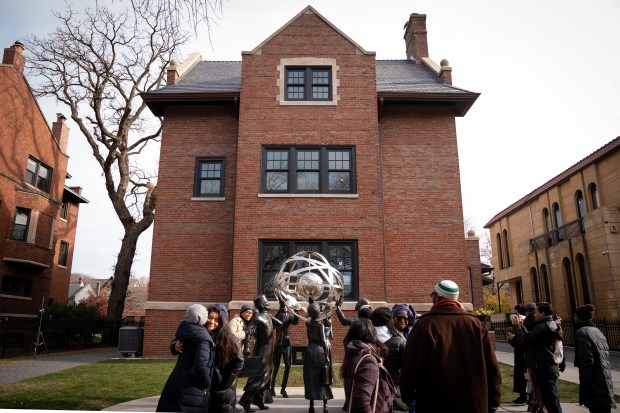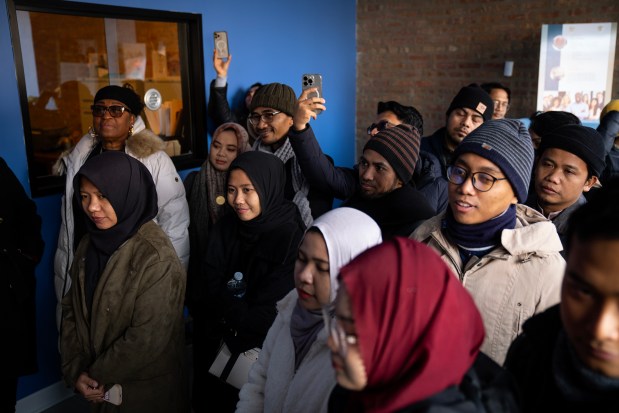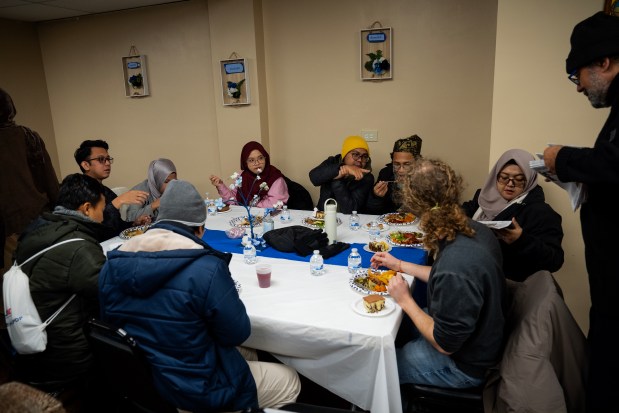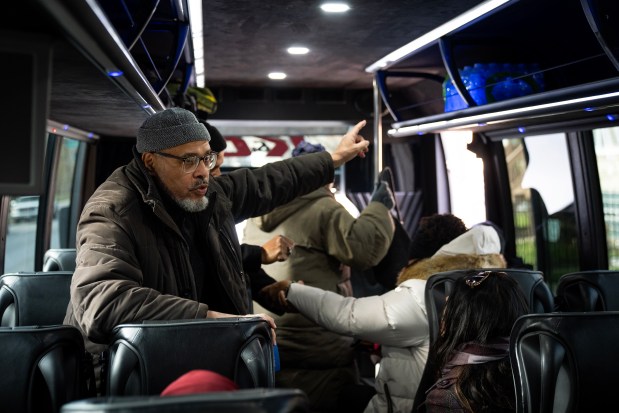“Assalamu alaikum. Welcome. Come on aboard.”
The six tour guides of the Chicago Black Muslim History Tour stood up to give and receive greetings of peace to a procession of guests as they stepped on the bus.
The group of visiting Indonesian scholars, leaders and faith educators was prepared for a cold day of learning and prayer as their rental bus shuffled and swayed and the tour guides’ mic was frustratingly difficult to use.
The hosts held printed notes with dates and names, and wore beanies, brimless kufi caps, neatly tied scarves and at least one black baseball hat with Arabic script saying “Allah” on it.
The community historians on the bus all had unique, firsthand views of Chicago’s important role in American Muslim history. The eldest of them, Bashir Asad, joined the Nation of Islam in the late 1968 during a time of rising interest in Black culture and history on the South Side.
Asad introduced himself to the group as the bus got moving.
“I’m sometimes in this community called ‘The Historian’ for my recollection of events,” he said, looking cozy in a knit cap and jacket. “In traditional African cultures, this person is known as a griot, a chronicler of African life.”
Some of these tour guides once had leadership or administrative roles at pioneering Muslim newspapers and schools. They were connected and met with historical figures such as Muhammad Ali, Elijah Muhammad or Warith Deen Mohammed, leaders who taught that Islam was the religion that would best address the historical damage slavery had done to Black America. Those leaders encouraged independent Black education, community development, abstinence from drugs and alcohol and many other changes.
The driving force for the tour guides is the idea that Black Americans and Muslims must unapologetically tell their own story, an experience that so many of their ancestors were robbed of due to slavery. This tour is a realization of that idea, of Black Muslim Chicagoans searching for freedom, justice and equality through Islam.
“The tour shows what is the distinct value, history and contribution of this particular segment of the Muslim community,” said Tariq El-Amin, resident imam of Masjid Al-Taqwa in Calumet Heights and founder of the tour. Masjid is the Arabic word for mosque. “It’s recognizing the diversity of Muslims we have in Chicago by clarifying what makes this particular community distinct and what its value is in a present and historical context.”
The tour is usually held only during Black History Month and on Juneteenth. But this December session was specially organized for an Indonesian delegation attending a certificate program for inter-religious peace-building at American Islamic College, with housing and assistance from the Lutheran School of Theology. The group was examining the importance in American history of Muslims of Black and African descent.
“We want to share the cultural, moral, economic, social and intellectual impact going back to 1934 here in Chicago,” El-Amin, the youngest of the guides, told the group, referring to the year the Nation of Islam came to Chicago. El-Amin started the first tour in 2022 after Al-Taqwa was added as a stop on the Chicago Interfaith Trolley Tour by the Chicago Theological Seminary.
Shermann “Dilla” Thomas, an urban historian who last week was appointed brand ambassador and social media chief of Chicago’s DuSable Black History Museum and Education Center, had not heard of the Chicago Black Muslim History Tour, but was encouraged when he learned about it.
Thomas, who leads his own bus tours that aim to fight segregation in Chicago, said many histories of the city ignore its rich Islamic traditions.
“We have a shared history and a shared connection in preserving that history, so that everybody’s story is told,” Thomas said. “Allowing all sides to participate in the telling of our shared history is the best tool to ensure any kind of accuracy.”
The Indonesian tour group was given a lot of background on the Nation of Islam, starting with its foundation in Detroit under Fard Muhammad in the 1930s. After Fard Muhammad disappeared and left behind many questions, his successor, Elijah Muhammad, led the Nation of Islam to national attention.

During this time, the Nation of Islam’s theology included the idea that God came embodied in the person of Fard Muhammad, and that Elijah Muhammad was his prophet. The leadership moved its headquarters to Chicago in the 1960s.
In 1975, Elijah Muhammad’s son, Imam Warith Deen Mohammed, or W.D. Mohammed, took over the Nation of Islam and transitioned the theology to be based on the Quran and sunnah, Islamic customs and practices based on the words and deeds of the seventh century Prophet Muhammad. Eventually, W.D. Mohammed decentralized and evolved the community, retiring the name “Nation of Islam.” He rejected the idea that Fard was God or that there could be another Muslim prophet.
“In 1975, the late Warith Deen Mohammed led the greatest conversion of Muslims to orthodox Islam,” El-Amin told the group.
“This is American history,” said tour participant Romana Manzoor, associate vice president of American Islamic College, an accredited school in Uptown. “You can’t talk about American or Muslim history without talking about Black Muslim history in this country.”
The first stop on the tour was Mosque Maryam and the adjacent Muhammad University of Islam grade school at 7351 S. Stony Island Ave. Maryam is the Arabic name for Jesus’ mother.
Originally a Greek Orthodox church built in 1952, the mosque was purchased in 1972 by Elijah Muhammad with a loan from Libyan leader Moammar Gadhafi and it became Temple No. 2 of the Nation of Islam.
Soon after W.D. Mohammed began moving toward orthodox Islam, another minister, Louis Farrakhan, split with the group, reclaiming the name Nation of Islam and bringing back some of Elijah Muhammad’s original teachings as he saw it. Now, Farrakhan’s community has its headquarters at Mosque Maryam.
Despite any doctrinal differences, Nation of Islam representatives warmly welcomed the visitors as partners. The group walked through a security screening into the mosque’s largest congregational area, gilded and beautifully white. It had wooden seating like pews in a church. The ritual prayer area, or Musulla, was under renovation downstairs and not part of the tour. Pointing at the dome, the group noted the word noor, or light, written in Arabic.
After learning a few more architectural and historical details, the group headed next door to the auditorium of the Muhammad University of Islam, where Jum’ah, the Friday congregational prayer, is held during the mosque’s renovation.
With a slideshow presentation, the school’s Principal Talib ul Hikmah Karriem explained the Nation of Islam’s history and theology.
“We were robbed of our names, our original language, our culture, our religion — Islam — and our God, Allah,” Karriem said.
The group walked through the K-12 school, where young students in suits and bowties sat at attention in brightly lit classrooms. But time was up. Participants got some bean pies — symbols of Black pride — from Supreme Bean Pie, located in the school, before heading to their next stop, the Elijah Muhammad House Museum at 4847 S. Woodlawn Ave.
On the ride over, the guides began fact checking with each other the historical stories presented at Muhammad University of Islam.
“Sister Clara Muhammad was the backbone of the University of Islam and she was a pioneer of home schooling,” said Clyde El-Amin, one of the other guides and no relation to Tariq El-Amin.
Under W.D. Mohammed, Clyde El-Amin worked as principal and coordinator of the national Islamic school system in the building we had just left. At the time, it was called the Sister Clara Muhammad Schools. “Warith Deen renamed it after his mother to honor her,” he said.
Elijah Muhammad bought his home in Hyde Park in 1952 and it became the leader’s longtime residence with his wife Clara Muhammad. According to Asad, it was a notable area for the Chicago elite and Muhammad wanted to establish the home as a symbol of Black economic development, civility and influence. He received Martin Luther King Jr. in the home in 1966. As the National House of the Nation of Islam, it acted as an embassy of sorts for the community.
But the house was sold and not preserved until real estate developer Sajdah Wendy Muhammad bought it in 2018. She’s working on restoring and renovating it, hoping to get the site further recognized for its historical importance.
“In religion, women are often left out,” she said to the group. “Women were pivotal in the building of the Nation of Islam and we want to tell their stories.”

Veronica Mwakasungura, a Ph.D. candidate at the Lutheran School of Theology in Hyde Park, who had joined the tour, was fascinated by the house. “I’ve driven past it and always wondered,” she said. “It stood out architecturally. So I was surprised I had not heard it was significant to the community.”
Back on the bus, Imam Rabbani Mubashshir spoke about the global importance of boxing legend and Islam ambassador Muhammad Ali. A murmur of recognition and assent came from the Indonesian group.
“He was one of the first Muslims I knew,” Mubashshir said. The year was 1965. “In my early life, when I was a teenager, I listened to him. I saw, in him, a whole new idea. He was really responsible for me becoming a Muslim.”
Ali helped fund the foundation of the Masjid Al-Faatir at 1200 E. 47th St. in 1987. There wasn’t enough time to visit all of the South Side’s significant Muslim sites, but Al-Faatir’s history was shared by Mubashshir as the tour passed the impressive building.
At the next stop, Salaam Community Wellness Center, Asad, the historian, pulled me aside, this time to fact check some of the names mentioned with Masjid Al-Faatir.

This fact-checking, oral history and shared discussion is key to the tour program being developed at Masjid Al-Taqwa. Frequently, the guides turned to each other to check their own historical facts, looking to the community member with the most knowledge.
At Salaam Community Wellness Center at 613 E. 67th St., which has been operating since 2020, CEO Dr. Constance Shabazz said the historical mission of South Side Muslims to improve community health is connected to their work at Salaam.
The Nation of Islam had plans to open a hospital and nursing home; Shabazz was a child then and considers this a realization of that historical dream. It provides holistic and traditional medical care, therapy and workforce readiness but also encourages nutrition. Even in winter, Salaam’s urban organic farm and hydroponic garden were being tended to.
The tour concluded with prayers at Masjid Al-Taqwa in the Calumet Heights neighborhood. The mosque has existed in many forms since the 1980s, but this location opened in 2019 at 9333 S. Escanaba Ave.

The building has become a repository of underdocumented American, Islamic and Chicago history. The founding imam, Mikal Ramadan, was unable to attend the tour, but said later that the mosque has been an important site as Black Muslims on the South Side deepened their understanding of mainstream Islam.
“Imam Warith Deen Mohammed came and taught at Masjid Al-Taqwa,” said Ramadan, a retired doctor who became a Muslim in 1962. Referring to a previous location of the mosque, he said, “At one point (W.D. Mohammed) was teaching once a month at Masjid Al-Taqwa.”
At the mosque, tour participants were served a lunch of fried fish, greens and Supreme Bean Pie and ate with the Al-Taqwa community.
Many of the Indonesian participants said they hadn’t considered that some of the earliest enslaved Africans brought to America were Muslim; many also said they were moved by the resilience Black Muslims had shown in American History.
“I wanted to learn about Islam in America and how they can coexist in a multicultural, multifaith community,” said Wardania Chusna, a school principal.

She said in Indonesia, Muslims are the majority. Seeing how Black Muslims are treated as a minority gave her some perspective on the power she holds in her own country.
“It’s very important for us as the majority to learn from the minority,” Chusna said.
As the group filed back onto the tour bus for its departure, Asad stepped on board to say goodbye and share a quote from W.D. Mohammed, whom he considered a mentor and teacher.
“Know that Muslims are bonded together as one family,” Asad read. “We are to love each other and put that love into practice.”
The quote was from a khutbah, or sermon, W.D. Mohammed gave in 2002 in Chicago, Asad said.
“The best proof of our love is that we want for our brother and sister what we want for ourselves,” Asad continued reading. “That we seek advancement and seek growth and progress, not to be selfish with it, but to share it with our brothers and sisters.”
The next Chicago Black Muslim History Tour is planned for Feb. 22. Information will be posted on the Masjid Al-Taqwa Facebook page. The Juneteenth tour has not yet been set.



